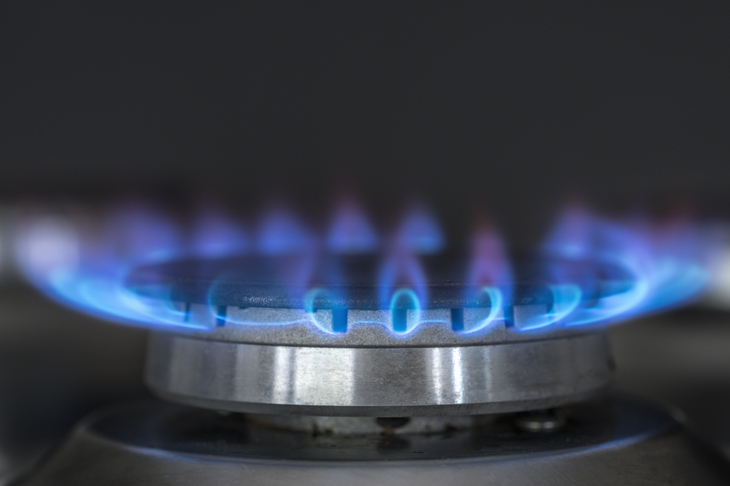It was a close-run thing for my friend who’s having a new kitchen installed in her house in Chiswick. After a persuasive campaign by her eloquent architect, who has an induction hob in his own house and loves it for its clean lines and hyper-efficiency, she had got as far as ordering one for herself. Having placed the order, she couldn’t sleep. She tossed and turned, worrying about the imminent change to her cooking life that the induction hob would (literally) induce, let alone the need to buy a whole new set of ‘induction-ready’ pans.
No more knobs to turn a fraction to the left while frying an omelette, ever again? Just a plus and minus touch-screen sign to jab with the ball of the index finger, 9-8-7-6-5-4 and down to 3? No more flames licking the pan, or the sizzling sound of putting an Aga kettle down on its hottest plate? Just a shiny black slab of glass with circles (called ‘zones’), for the rest of her life? Goodbye to the cooking instincts developed over a lifetime, for the sake of an easily wipeable surface and being able to boil a pan of pasta water in 90 seconds if you press ‘power boost’?
She sought advice from friends. Some screamed. ‘Don’t do it!’ ‘They’re the work of the devil!’ ‘They’re totally counter–intuitive!’ ‘If you get so much as a drop of water on the controls, the whole thing switches off.’ Others were enthusiastic. One said: ‘Induction hobs are fine. Don’t worry.’
Fine? It was that adjective of faint praise that changed her mind once and for all. She cancelled the order and rushed off to buy a gas hob instead. On hearing this, I breathed a sigh of relief — much like the ‘sigh’ an induction hob makes if you place the wrong kind of saucepan on it. ‘We call ours “the Snob Hob”,’ remarked a friend, telling me about that sigh. ‘The instruction manual says: “Do not use common steel.”’
My sigh of relief was the battle sigh of all artists and poets in the ongoing war between artists and scientists, which the scientists are winning. First they tried to get us to give up fireplaces in favour of central heating, and books in favour of kindles. Now they’ve invented a way of cooking that is so cleverly, intriguingly scientific, as well as ‘planet-friendly’ and safe — a way of cooking-by-numbers in which nothing gets hot except the food itself — that we’re being cajoled into parting ways with the instinctive method of cooking with fire that’s been cheering us up twice a day for 1.5 million years. That was cooking as an art. Welcome to cooking as a science; and it’s those who delight mainly in methods and systems who relish this change.
The induction saucepan gets hot, but only because the food inside it does. That is what thrills anyone who has a primarily scientific outlook on the world. Gazing down into the magnetic saucepan, having jabbed first up to ‘nine’, you can remind yourself that the contents are turning from raw to cooked not because something hot is underneath them, but because an alternating eddy current is making a fluctuating magnetic field that, indirectly, is producing heat.
How the induction zealots enjoy explaining all this. A cousin and convert in Scotland admits that his wife is getting tired of the science lectures he keeps giving to visitors. ‘Induction creates heat energy inside the pan itself, instead of firing it up from the outside.’ Then he’ll say: ‘Look: the hob doesn’t even get hot! Try it for yourself! Put your finger on it.’
I have no desire, nor have I ever, to put a finger on a hob to see whether or not it’s hot. Induction converts want to make us believe that thanks to the phenomenon of induction, they’re saving us from those weekly visits to A&E when children were milling about in the kitchen touching the hob.
They never did. I’m more worried about children burning their fingers now, when people keep telling them to ‘try it’. Induction manuals warn: ‘Do not ever put your hand on the cooktop, because it might have become dangerously hot from the pan that has been standing on top of it.’ Don’t blame the hob; blame the saucepan. I don’t care what causes the burn. It’s still a burn.
More worryingly, a typical instruction manual says: ‘Seek doctor’s advice before use if pacemaker fitted.’ I checked on this. The British Heart Foundation’s website advises you to ‘keep a distance of at least two feet between the stove top and your pacemaker. Most people should be able to use an induction hob if they follow these precautions.’ In other words, if you have a dodgy heart and choose to cook with the devil, be sure to use a two-foot spoon.
Go into any kitchen shop and you’ll see induction hobs everywhere. They’re taking over, pushing out gas. ‘It’s the way things are going,’ the salesman at Peter Jones tells me, although he admits to cooking with gas at home. The hobs look so like a continuation of the worktops into which they are embedded that you don’t even realise they are hobs. The only signs that give them away are a brand name, some faint circles, some tiny plus or minus signs at the front, and a ‘key’ icon (the ‘lock’ feature).
I do see that induction hobs, for people with no access to gas, are preferable to their electric or halogen predecessors, although those did at least glow red, whereas induction hobs (dismally) don’t glow at all. Halogen hobs were so agonisingly slow to heat up that boiling a tiny saucepan of frozen peas could take 25 minutes. They were then so slow to cool down — ten times slower than waiting for the red man to go green at a pedestrian crossing — that you could only control any cooking by removing the saucepan entirely from the scene. Those hobs really did stay dangerously hot for half an hour after they ceased to look hot. I see why people love these new energy-efficient, fast-cooking and above all easy-to-clean hobs, by comparison, and it’s cheering to know that the Aga brand does have knobs, so it’s a knob hob as well as a snob hob.
But with their hypersensitive touch-screens and habit of shutting down for safety reasons if you do anything wrong, they are making it harder than ever for the uninitiated to be of much use in other people’s kitchens. Babysitting grandparents are being made to feel very old when they can’t get them to work after their wrinkled fingers touched the lock feature by mistake. The grandfather has to put his reading glasses on and study the manual’s ‘FAQs’ section for an hour.
And in Airbnb accommodation across the globe, and especially (I gather) in Dubai, homesick guests are bursting into tears because the ‘39/40’ error code has started flashing, the whole hob has stopped working, and the owner is not answering his phone.
Got something to add? Join the discussion and comment below.
Get 10 issues for just $10
Subscribe to The Spectator Australia today for the next 10 magazine issues, plus full online access, for just $10.
You might disagree with half of it, but you’ll enjoy reading all of it. Try your first month for free, then just $2 a week for the remainder of your first year.














Comments
Don't miss out
Join the conversation with other Spectator Australia readers. Subscribe to leave a comment.
SUBSCRIBEAlready a subscriber? Log in